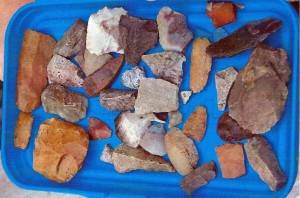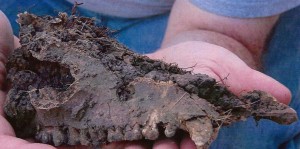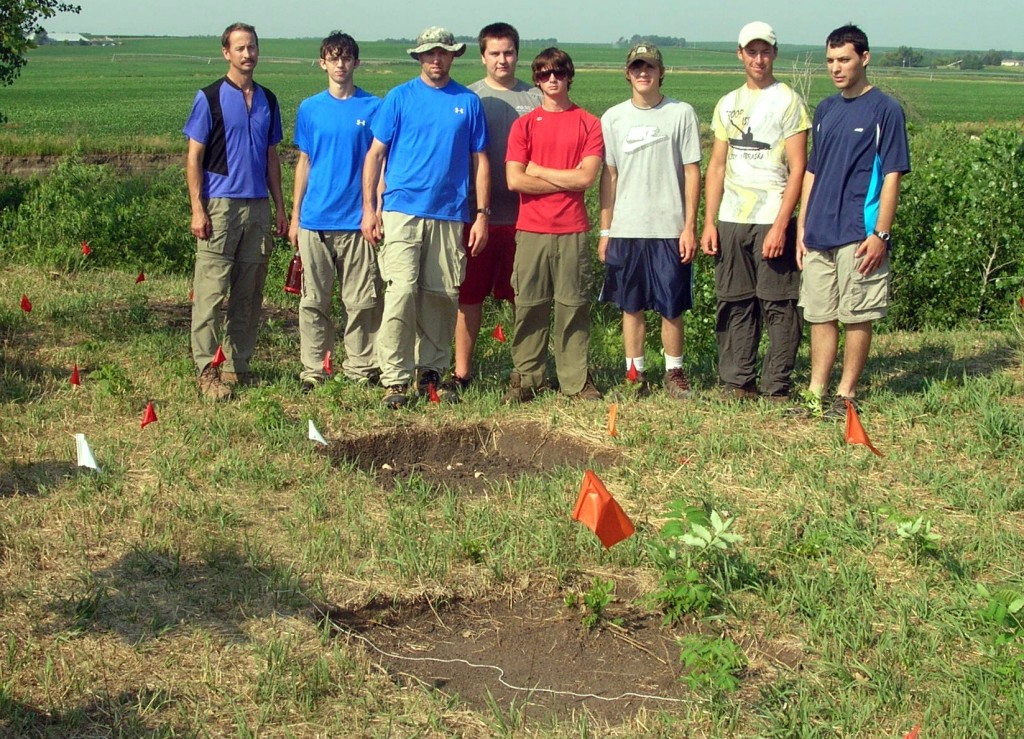Though not a trained archaeologist, the existence of some very unusual earthen mounds on our farm led me to research a variety of subjects, including archaeoastronomy, in order to gain a better understanding of these mounds. I eventually put together a Report about this site for the Nebraska State Historical Society.
Assorted stone tools found at farm
Recently a team of three archaeologists, led by Nebraska State Historical Society archaeological collection curator Trisha Nelson, helped Lori, the kids and me begin a salvage excavation of a Native American earthlodge that is rapidly eroding away on a steep bank overlooking the Beaver Creek (the hog skull on the left was revealed by erosion in a trash pit near the lodge).
This project is a dream-come-true for me — I’ve always known there were Native American remains on the property — but this is the first chance I’ve had to work with professional archaeologists to systematically explore anything. I’ll be posting updates below about this project on this site over the course of the dig.
June 5
After Nolan Johnson, Trish, and Nick Fogerty arrived at the farm, the first step in preparing for the salvage dig was for Trish and Nolan to establish a grid consisting of squares 1 meter in size (we had cleared the site of brome grass and sumac a couple of days earlier). Once digging began, Nick showed Angela how to screen for small artifacts.
June 8
On the first day we excavated a square meter down to a depth of 10 cm. Unfortunately, nothing was found in that location, and Trish, Nolan and Nick had to leave before we could go farther, taking their folding screen with them. A screen is necessary to sift the dirt to reveal small artifacts and we could not continue until we’d built a screen of our own. Though we didn’t have any plans or dimensions, we tried to copy the archaeologists’ screen as best we could. So far we’re pleased with our results…

June 15
We began by screening some of the loose dirt that had fallen from the side of the bank. Unfortunately, though it was easy to dig, we only found one small fragment of pottery. We did notice, though, a large area of what may be ash exposed in the side of the bank by erosion.
Back up on the top of the bank, we decided to skip a square and excavate closer to the edge of the bank. The ground was extremely hard and became even harder after the first 10 cm. We found several shards of pottery, a few stone flakings and one fairly large projectile point. We also found fragments of white porcelean, indicating that this site was occupied after contact with White traders.
June 28
I met with Boone Central school superintendent Cory Worrell. Cory is very interested in connecting his teachers and students with the dig when school resumes in the Fall. He’s going to tell the teachers about it and any who are interested will call me to make arrangements.
June 30
Busy schedules and extreme heat have been keeping us from digging as much as we’d like. The local Boy Scouts hiked from Albion to our farm on the evening of June 29th, camped overnight, and I joined them in the morning to give them a tour of the Native American sites. They seemed very interested in the people who once lived there and were also interested in helping dig “when it cools off a little!”
Members of Boy Scout troop 155 who visited the dig site: (l to r) Todd Wynn, Benjamin Zwiener, David Zwiener, Luke Johnson, Alec Wynn, Justin Christensen, Luke Schmitz and Shawn Kratochvil.





